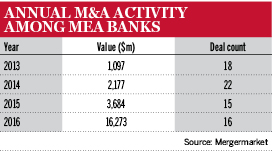Until their ambitious reform plans start to bear fruit, the six economies of the Gulf Co-operation Council (GCC) must continue to endure the challenge of lower oil prices. With the region’s aggregate gross domestic product growth expected to hit just 1.6% over the 2017-18 period, according to rating agency Moody’s, there are few bright spots on the horizon. In this slow growth environment, Gulf banks are facing up to persistent – but at least stable – pressures in the form of tightened liquidity and a greater cost of funds.
Some banking markets in the GCC were expected to undergo a round of consolidation to cut costs and address liquidity shortages in response to these challenges. But as data from Mergermarket covering announced bank-to-bank merger and acquisition (M&A) activity in the Middle East and Africa in 2016 shows, this has failed to happen. Only one headline deal, the merger between National Bank of Abu Dhabi (NBAD) and First Gulf Bank (FGB), came out of the GCC last year.
This deal, which Mergermarket values at $14bn, has distorted the trend data for the year’s M&A report, because although 2016 shows another year-on-year increase in announced deal activity for the GCC, as well as the wider Middle East and Africa region, without the contributions of the NBAD-FGB merger the total deal values for the year fell compared with 2015.
Low consolidation
In addition to a lack of regional consolidation, the 2016 Mergermarket data surveys the first year since 2014 in which the largest Gulf banks have not announced a major outbound deal involving another lender in a higher growth market.
“M&A activity among GCC banks is still unusual, despite the tougher operating environment across the region,” says Redmond Ramsdale, head of GCC bank ratings at Fitch Ratings.
Local market dynamics are largely responsible for this lack of consolidation. The ownership structures of Gulf banks, in which local, private shareholders often own significant stakes and are reluctant to relinquish their positions, are one obstacle. Another is the composition of some banking systems. While a handful are deemed overbanked, others, such as Saudi Arabia, have relatively few domestic banking institutions. Cumulatively, these factors, and others, have led to a dearth of M&A activity within the region.
“Large shareholders in Gulf-based banks are particularly averse to M&A activity because it would mean a dilution of their position,” says Chiradeep Ghosh, research manager at the Securities and Investment Company in Bahrain.
Not over yet
Meanwhile, tougher economic conditions at home, combined with less attractive valuations of acquisition targets in higher growth markets beyond the Gulf, have ended the outbound M&A boom of the past few years. According to Mergermarket’s data, no major outbound M&A deals were announced between banks in the GCC and other regions in 2016. This follows significant buy-ins to Turkey, Egypt and sub-Saharan Africa in 2014 and 2015.
“I think we’re going to see a deceleration in outbound M&A activity from the GCC banks. The attractive valuations in key markets such as Turkey and Egypt are no longer there, while earnings and profitability are feeling the squeeze at home,” says Mr Ramsdale.
This is not to say that M&A among Gulf lenders is at or heading for a complete standstill. Most observers agree that, for the time being, a low level of activity will be observed in the upper and lower tiers of the regional banking sector. This will lead to headline deals akin to the NBAD-FGB merger, which benefit from top-down government support. “We believe the NBAD-FGB merger was possible with support from the ruling family and government,” says Mr Ghosh.
Indeed, the deal is expected to elevate the newly merged National Bank of Abu Dhabi to a new regional and international level. “A larger equity book comes with big advantages. NBAD can now take a bigger share of the pie of all big projects in the United Arab Emirates and may even compete with Qatar National Bank (QNB) for some of the region’s big-ticket development projects,” says Mr Ghosh.
Top-level support
The Abu Dhabi authorities are not alone in pushing for the strategic consolidation of their lenders. A proposed three-way merger between Qatari lenders Masraf Al Rayan, International Bank of Qatar and Barwa Bank is significant because it is backed by the country's government. According to a joint statement by three banks issued to Reuters in late December 2016, the deal, if completed, would create a new fully sharia-compliant banking entity with total assets of $44bn.
“Qatar would no doubt like the biggest Islamic bank in the GCC and globally to be a Qatari bank, in the same way it has created the largest GCC bank in the form of QNB, which will remain so, despite the merger of NBAD and FGB in the UAE,” says Mr Ramsdale.
Elsewhere, the structure of banking systems in other markets, including Bahrain and the UAE, may speed up consolidation in the coming years. By the third quarter of 2016, the UAE boasted 23 local and 28 foreign banks. Bahrain, meanwhile, has a mix of 113 locally incorporated and foreign banks, including specialist wholesale and retail lenders and Islamic banks. These markets are frequently identified as overbanked by regional observers.
“Rising costs and liquidity constraints are potential drivers of future consolidation. But the fact that some markets are overbanked will be a greater incentive for M&A activity,” says Scott Campbell, national managing partner at law firm Linklaters. “Further consolidation in these jurisdictions will lead to cost-cutting by the banks while improving the competitive landscape and ameliorating many lenders’ liquidity issues. All of this will be beneficial for the consumer.”
But within the GCC any future deals are likely to come in the form of mergers because they require no additional capital, according to Mr Ghosh. “It’s not easy for a bank to execute an outright acquisition of another bank because it leads to a reduction in its capital adequacy ratio. A merger is a much more likely scenario in the current context, otherwise they would have to raise fresh capital,” he says.
Unchanging landscape
Irrespective of the form that consolidation takes, some regulators across the GCC are keen for it to happen. The ultimate ambition is to strengthen their respective banking systems by shoring up liquidity and fortifying the balance sheets of their constituent lenders.
“We are seeing increased regulatory flexibility and support from central banks and other regulators to enable these sorts of deals to happen,” says Mr Campbell.
Despite the strong regulatory backing and an operating environment in which consolidation makes sense, it seems that, for the time being, M&A activity among Gulf banks will remain limited to the upper-tier banks backed by their respective governments and lower-tier lenders in the most overbanked markets. But in many cases the practical impediments to mergers and acquisitions will be too onerous to overcome.
“Even in cases where mergers appear to make sense, such as the planned merger of Bank Dhofar and Bank Sohar in Oman, negotiations can be protracted and difficult,” says Mr Ramsdale.
Looking ahead, these impediments to consolidation are likely to limit any significant change to the GCC’s banking landscape. Barring a materially negative change to global oil prices, banks in the region will continue to weather the current challenges in a way that will preserve the status quo.













